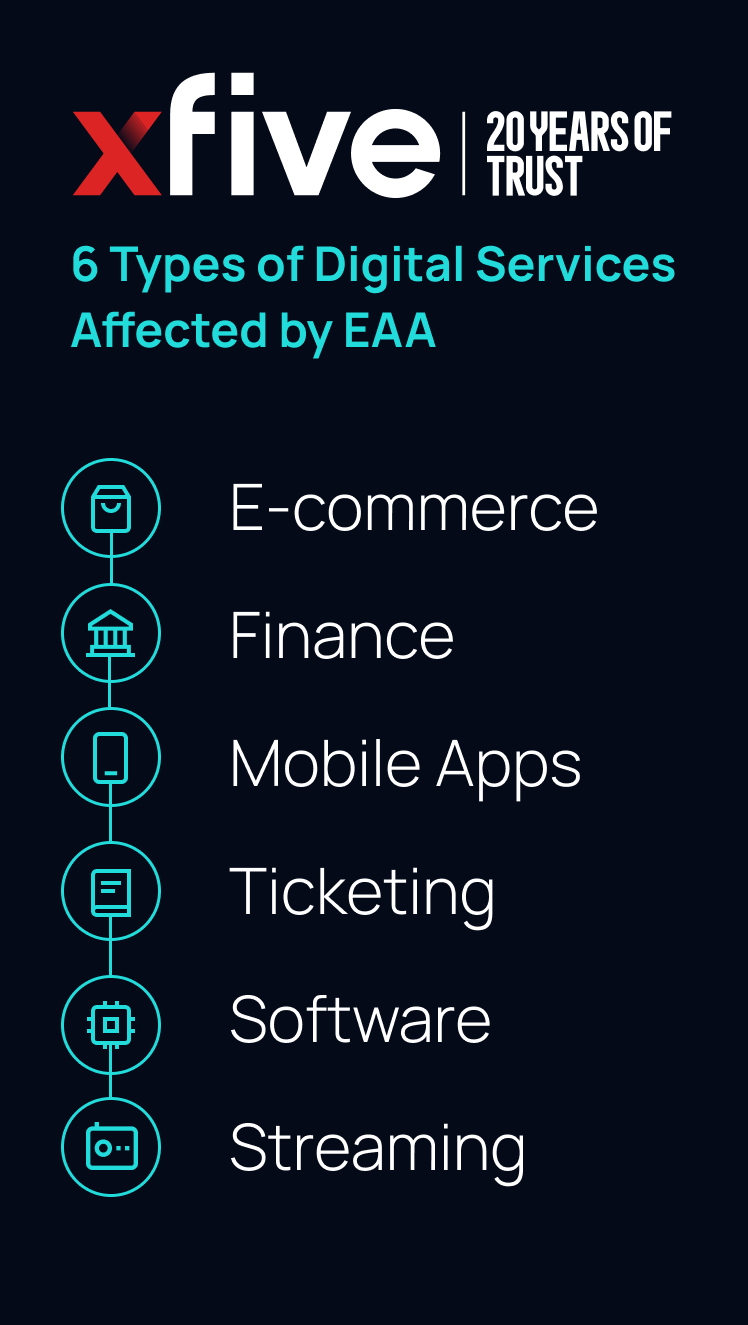The European Accessibility Act (EAA) goes into full enforcement in June 2025 — and it’s more than a legal milestone. For many digital businesses, it’s a moment of truth.

If you offer digital products or services to users in the EU, the EAA likely applies to you. The question is: are you ready?
Here’s a practical guide to who’s affected, what’s at stake, and how to meet the standards before the deadline.

6 Types of Digital Services Affected by the EAA
The EAA covers a wide range of digital offerings. If your business provides any of the following, you fall under its mandate:
1. E-commerce websites
From multinational platforms to boutique online stores, if your site facilitates transactions, it must be accessible. This means:
- Clear navigation
- Keyboard-accessible checkout
- Alt text for product images
- Accessible forms
2. Mobile applications
Apps for banking, travel, productivity, or entertainment are all included. EAA requires:
- Support for screen readers
- High-contrast mode
- Logical gesture alternatives
3. Financial services
Online banking, fintech tools, and investment platforms must meet accessibility standards to ensure financial inclusion.
4. Ticketing and transport systems
Booking tickets for trains, planes, events, or attractions? Interfaces must allow users with disabilities to:
- Select travel times
- View seat availability
- Complete purchases independently
5. Streaming and eBook platforms
Platforms delivering audio, video, or written content need to:
- Offer captions and transcripts
- Support screen readers
- Enable keyboard navigation
6. Software sold in the EU
Any downloadable or cloud-based software targeting EU users must follow accessibility protocols, including documentation and support interfaces.
What About Microenterprises?
Businesses with fewer than 10 employees and under €2 million in turnover are exempt. But that doesn’t mean accessibility isn’t relevant.
Consumers are already demanding more inclusive digital experiences. Proactive accessibility isn’t just the right thing — it’s a competitive edge.
Accessibility Is a Business Strategy, Not Just a Regulation
Here’s why accessibility is a strategic decision, not just a legal one:
Reach more users
1 in 5 people in the EU live with a disability. An aging population increases this number every year.
Strengthen your brand
Demonstrating inclusivity builds trust, brand equity, and customer loyalty.
Improve user experience
Clear design, logical structure, and keyboard access help all users — not just those with disabilities.
Spark innovation
Building for edge cases often uncovers better ideas for everyone.
What Happens If You Don’t Comply?
Each EU country enforces the EAA through national bodies. Non-compliance may lead to:
- Fines — Financial penalties scale based on company size and severity of the violation.
- Service suspensions — You could be ordered to stop selling or operating non-compliant services.
- Public exposure — Authorities may publish lists of non-compliant companies, damaging reputation and trust.
What You Need to Comply With
Meeting EAA requirements means addressing all parts of your digital ecosystem — not just the homepage.
WCAG 2.1 AA
Internationally recognized accessibility guidelines. These cover:
- Text alternatives for images
- Sufficient color contrast
- Keyboard-only navigation
- Logical heading structures
EN 301 549
A broader EU standard for software, web, mobile, and hardware accessibility. It includes WCAG but also covers:
- Documentation
- Support services
- Application interfaces
Full content compliance
Every touchpoint — UI, help docs, onboarding flows — needs to be accessible.
EAA Compliance Is a Journey — Not a Checkbox
Accessibility isn’t one and done. It’s a continuous commitment to inclusive design and development. It means:
- Embedding accessibility into design sprints
- Testing with users of diverse abilities
- Training teams to spot and fix barriers
- Auditing regularly
How xfive Can Help
At xfive, we don’t tack on accessibility at the end — we build it in from day one.
We offer:
- WCAG and EN 301 549 audits
- Remediation and implementation
- Inclusive UX/UI design
- Developer and stakeholder education
Let’s turn compliance into confidence — and make your digital product work for everyone.
👉 Explore our accessibility services
EAA Compliance FAQ
Who does the European Accessibility Act apply to?
Most digital businesses serving users in the EU — including ecommerce, mobile apps, finance, media, and transport.
Are small businesses exempt?
Yes, microenterprises are legally exempt — but user expectations still apply.
What standards do I need to meet?
You’ll need to comply with WCAG 2.1 AA and EN 301 549 accessibility standards.
What are the penalties for non-compliance?
They vary by country but can include fines, public listing as non-compliant, or being barred from offering digital services.



